Trees Birds Mammals Fish Amphibians Reptiles
Wild Algarve
Bookshop
Coprinopsis atramentaria (Bull.) Redhead, Vilgalys & Moncalvo - Common Inkcap
Phylum: Basidiomycota - Class: Agaricomycetes - Order: Agaricales - Family: Psathyrellaceae
Distribution - Taxonomic History - Etymology - Identification - Toxicity - Reference Sources
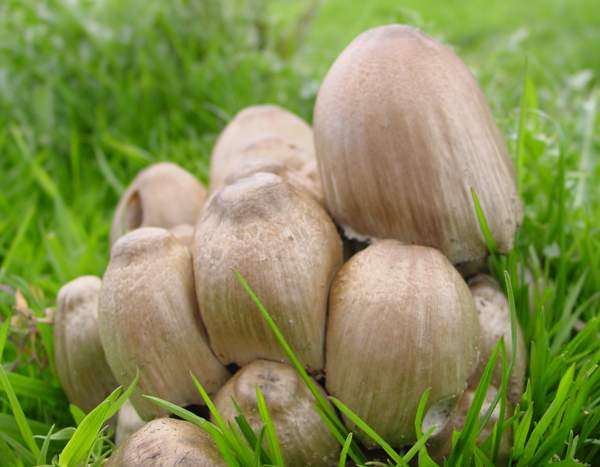
From tree stumps or buried wood of deciduous hardwood trees, Coprinopsis
atramentaria, the Common Ink Cap, arises in small clumps from
spring until early winter. This is certainly a powerful mushroom: it has been known to burst through asphalt and even to lift the corners of paving stones where its mycelium has been covered over during the winter months. Research has shown that it is the immense strength of the vertically-aligned hyphae in the stems that give these mushrooms so much muscle.
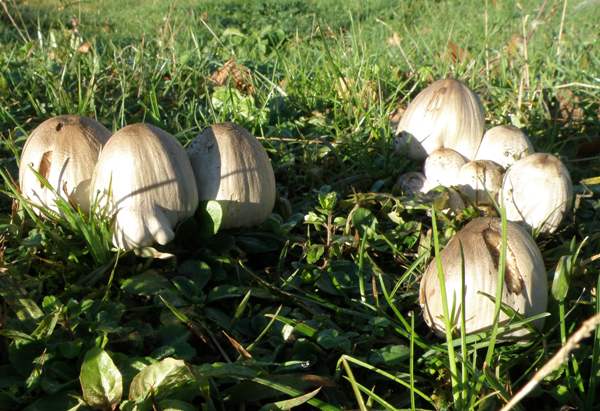
Distribution
Frequent in Britain and Ireland and throughout Europe and North America, the Common Inkcap usually appears in clusters but occasionally as solitary specimens.
Taxonomic history
The common ink cap was first described scientifically in 1786 by the French botanist and mycologist Jean Baptiste Francois Pierre Bulliard, who named it Agaricus atramentarius. (Most gilled fungi were initially dumped into a gigantic Agaricus genus.) The great Swedish mycologist Elias Magnus Fries transferred this species to the genus Coprinus in 1838, and there as Coprinus atramentarius it resided until DNA analysis by Redhead, Vilgalys & Moncalvo resulted, in 2001, in the genus Coprinus being reduced to very few species. Most of the inkcaps are now in new genera sited within the family Psathyrellaceae.
Synonyms of Coprinopsis atramentaria include Agaricus atramentarius Bull., Agaricus luridusBolton, Agaricus sobolifer Hoffm., Agaricus plicatus Pers., Coprinus atramentarius (Bull.) Fr., and Coprinus plicatus (Pers.) Gray.
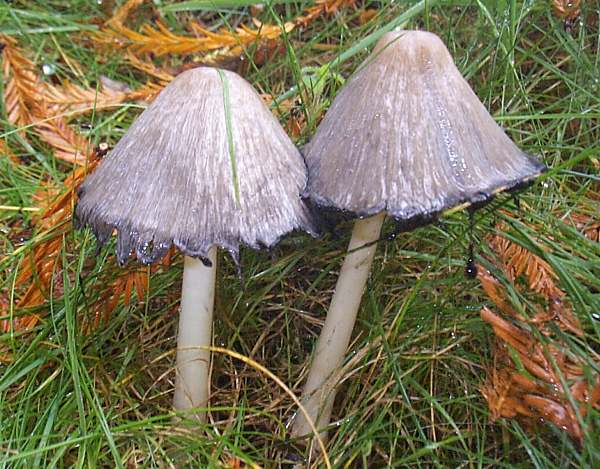
Etymology
The generic name Coprinopsis indicates that this mushrooms genus is similar to the genus Coprinus, which literally means 'living on dung' - that's true of quite a few of the inkcaps but not particularly apt for this and several other species. The specific epithet atramentaria comes from the Latin 'atramentum' meaning a very dark or black substance, in particular a liquid such as ink.
Common names change with time and location. In America the terms Inky Cap or Inky-cap are most commonly used, while in many older field guides published in Britain you are likely to see Ink Cap or Ink-cap rather than Inkcap.
Toxicity
The Common Inkcap is poisonous when consumed in conjunction with alcohol, and the effects are sometimes severe. It is therefore unwise and can be dangerous to eat these inkcap mushrooms if alcohol has been consumed during the three days before a meal or is likely to be consumed at any time during the three days afterwards.
Identification guide
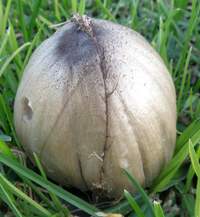 |
Cap
At first egg-shaped and mostly smooth with just a small central area covered in small flattened scales; without veil fragments,
the cap of Coprinus atramentaria later expands to become bell-shaped with a slight umbo before
deliquescing from the margin.
Grey or grey-brown before turning black, caps attain a diameter
of 3 to 7cm. |
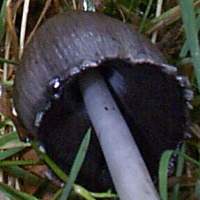 |
Gills
The free, crowded gills of the Common Inkcap are white at first,
turning brown and then black before autodigesting.
Stem
White with reddish-brown fibrils towards the
base; 8 to 15mm diameter and 5 to 12cm tall. |
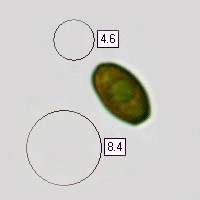 |
Spores
Ellipsoidal to almond-shaped, smooth, 7.5-11 x 4.5-6μm; with an apical germ pore.
Spore print
Black. |
Odour/taste |
Not distinctive. Warning: poisonous if consumed either with or a day
or two before/after alcohol. |
Habitat & Ecological role |
Saprobic; on or beside stumps (usually hardwood); also
beside woodland footpaths and at the base or trees in parks and
gardens. Also fairly common on tree-lined grassy roadside verges or in parkland where fallen timber has become buried under dead grass. |
Season |
May to November in Britain and Ireland. |
Similar species |
Coprinellus micaceus occurs in similar habitats but is smaller and redder and when young has
mica-like veil fragments on the surface of the cap. |
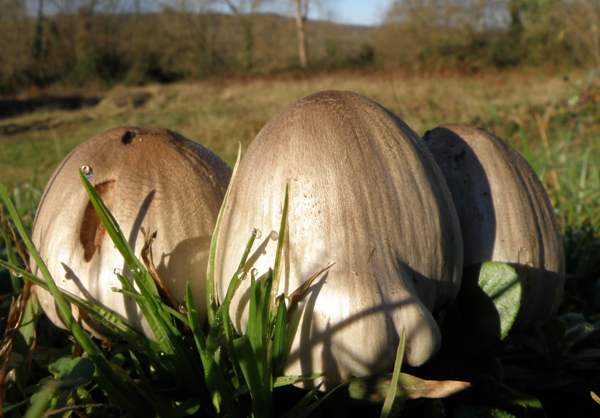
Reference Sources
Fascinated by Fungi, 2nd Edition, Pat O'Reilly 2016, reprinted by Coch-y-bonddu Books in 2022.
Orton, P.D. & Watling, R. (1979). British Fungus Flora: Agarics and Boleti. Vol 2. Coprinaceae: Coprinus. Royal Botanic Garden: Edinburgh.
Redhead SA, Vilgalys R, Moncalvo J-M, Johnson J, Hopple JS Jr.; Vilgalys, Rytas; Moncalvo, Jean-Marc; Johnson, Jacqui; Hopple, Jr. John S (2001). 'Coprinus Pers. and the disposition of Coprinus species sensu lato.'. Taxon (International Association for Plant Taxonomy (IAPT)) 50 (1): 203–41.
BMS English Names for fungi
Dictionary of the Fungi; Paul M. Kirk, Paul F. Cannon, David W. Minter and J. A. Stalpers; CABI, 2008
Taxonomic history and synonym information on these pages is drawn from many sources but in particular from the British Mycological Society's GB Checklist of Fungi.
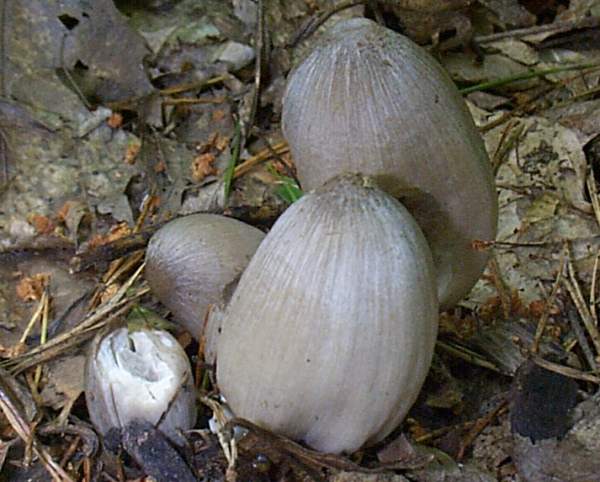
Top of page...
Fascinated by Fungi. Back by popular demand, Pat O'Reilly's best-selling 450-page hardback book is available now. The latest second edition was republished with a sparkling new cover design in September 2022 by Coch-y-Bonddu Books. Full details and copies are available from the publisher's online bookshop...